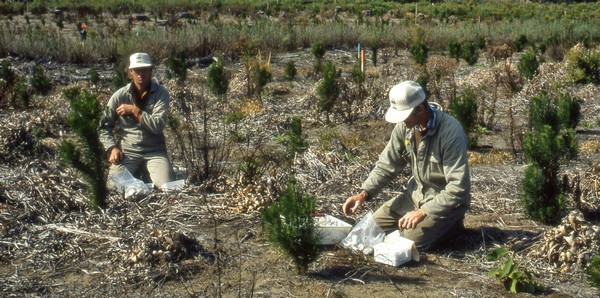Forest ecosystem nutrient levels and forest productivity have been monitored over a complete forestry rotation by Scion researchers.
The results show that soil nutrient levels and forest productivity can be maintained with site-specific management – specifically through the retention of forest harvest residues and the forest floor at low-fertility sites.
Around 15 per cent of New Zealand’s planted radiata pine forests are now in their third or fourth rotation. A consistent supply of nutrients is essential to ensure the long-term productivity, health and sustainability of these forests. This is not a new issue, with concern being raised more than 40 years ago.
Harvesting a forest includes removing the main stem but can also include removal of harvest residues (slash) and even the forest floor, a scenario which is becoming increasingly more plausible as biomass for bioenergy and biofuels are emerging as ways to diminish our reliance on fossil fuels. Understanding the consequences of these practices from one rotation to the next is necessary to ensure our forests stay productive into the future.
A series of six trials were installed in New Zealand to understand the impact of harvest residue removal on long term site productivity. Three core harvest removal treatments were installed, removing the stem only, removing all forest residues (or the whole tree) and removing the whole tree and the forest floor. Soil, forest floor and tree nutrient levels were measured before harvest, at age 5 years and for some sites at mid rotation and again when the forests were ready to harvest again.
Soil nutrient levels varied considerably from site to site. As expected, more carbon and nutrients were removed when the forest floor was disturbed, which can happen during harvesting and preparation for planting. However, by the end of the rotation, the forest floor had recovered, with one exception – when the forest floor was removed at a low nutrient site. The removal of large amounts of nutrients in harvest residues and forest floor had no effect on wood quality. These results suggest the soils and forest floor were generally able to supply adequate amounts of nutrients and, with time, the nutrient stocks were replenished.
Very large amounts of nitrogen fertiliser that were experimental in nature were also applied during the trial to counteract any nutrient limitations caused by the harvesting treatments. Adding fertiliser increased early rotation productivity, especially effective at sites where soil nitrogen stocks were initially low.
Other outcomes of the three decades of work include:
- Site-specific management recommendations to support the use of residue for bioenergy.
- Contributing to the development of a New Zealand planted forest specific Nutrient Balance Model (NuBalM).
- Insights into the effects of different harvesting treatments and fertiliser addition on soil biodiversity.
- Underpinning data for planted forest carbon accounting.
This work is part of the global “Long Term Site Productivity” trials investigating the sustainability of intensive forest management harvesting practices and the pressures placed on soil resources as the global demand for wood increases. New Zealand is the first country to complete and report on a full rotation of the Long Term Site Productivity harvest removal experiments, largely due to the rate at which radiata pine grows in this country.
The results from this work are already being used by the forestry industry to develop and implement site-specific nutrient management plans. Understanding the potential effects of forestry residue removal on some sensitive sites allows for site specific harvesting (and preparation) plans that ensure residues are retained and evenly spread. They are also essential for public acceptance of commercial forestry and to meet the requirements of external bodies such as the Forest Stewardship Council.
The forestry industry can be confident it can sustainably supply timber, fibre and energy into the future. The shared knowledge generated has led to changes in forest management and strengthened Scion’s relationship with the industry. Beyond the day-to-day, the raft of academic papers published has reinforced Scion’s reputation as a leader in forestry science.
“Forestry is also about land management and ecosystem resilience. Engaging with Scion researchers to further the science and management of long-term sustainability and resilience of our forests is a key strategy for our company.” - Dr Paul Adams, Forest Estate Manager, Rayonier Matariki Forests
Funders: Ministry of Business, Innovation and Employment, New Zealand Forest Growers Levy Trust Inc, New Zealand Forest Owners Association and New Zealand Farm Forestry Association, Strategic Science Investment Fund
Collaborators: New Zealand forestry companies and managers, University of Toronto; Oregon State University

